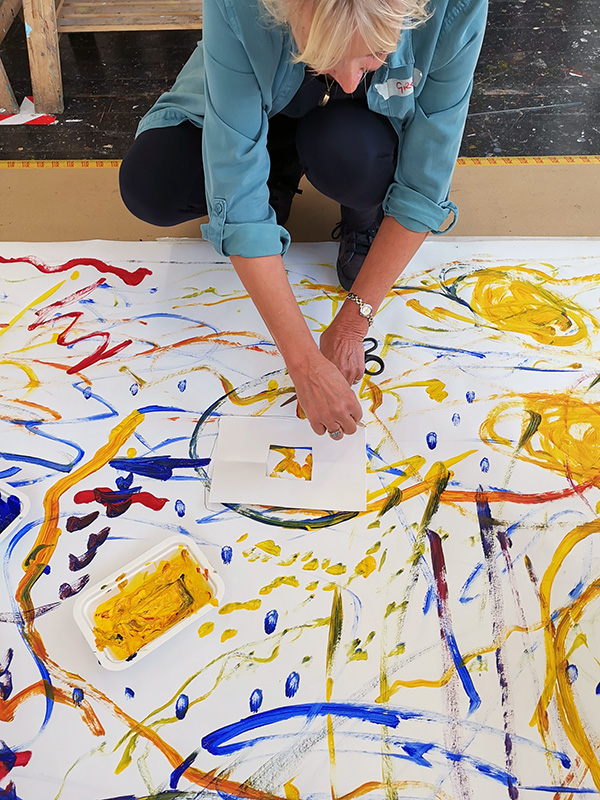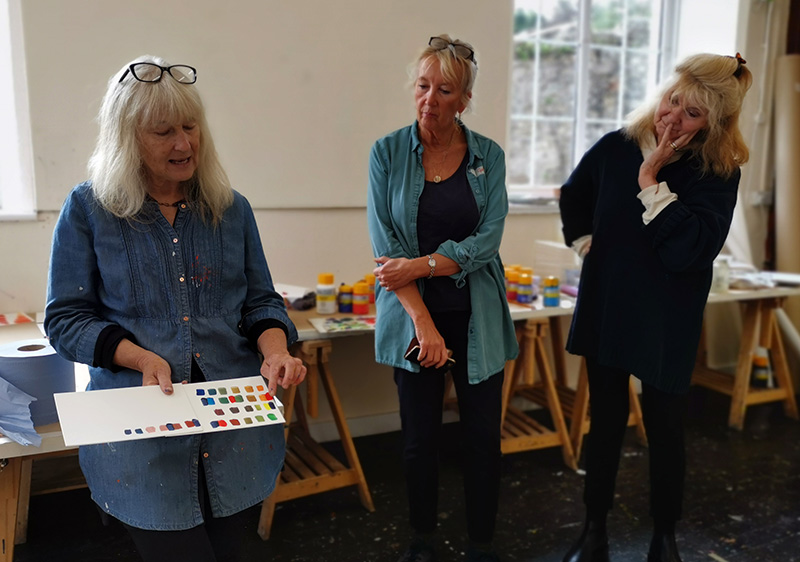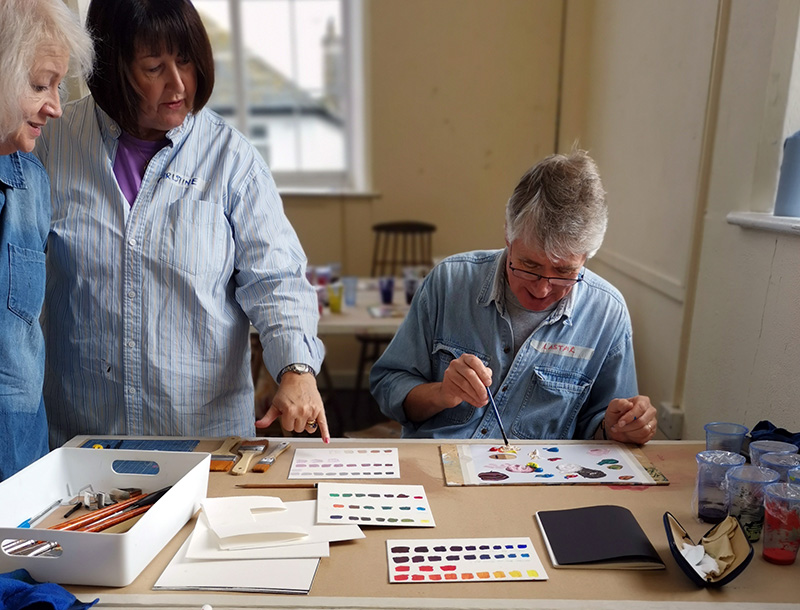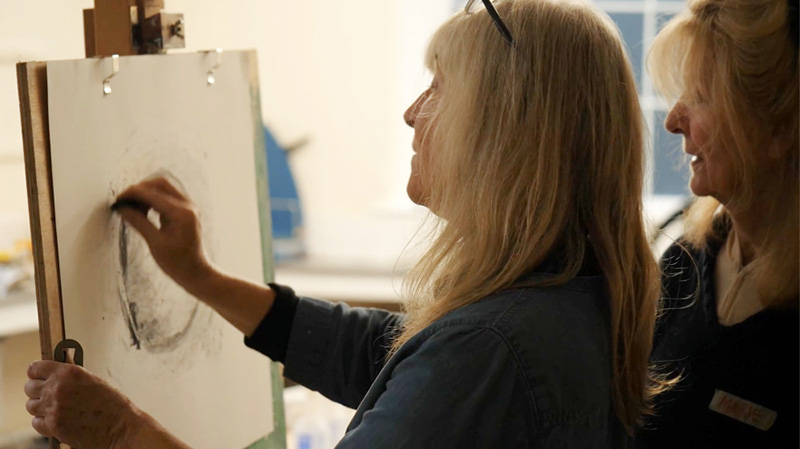The studio is alive with conversation. There is a feeling of excitement and trepidation in the air: the majority of students here haven’t picked up a brush or pencil since art class at primary school and some are expressing doubts that they will be able to paint anything recognisable at all. As our tutor Marie-Claire introduces herself to us, however, she quickly dispels any nerves: "Anyone can engage with making art," she reassures us. "I want you to know, that you can’t go wrong here. Learning to draw and paint is really about developing a new voice. I’m very much of the mind that there’s no right way or wrong way of making art, there’s only your way. And this time together is about learning to appreciate your way of doing it. And besides," she smiles, "the beginning is always a lovely place to be."
We begin with what Marie-Claire terms as an ‘icebreaker exercise’. The idea is simply to get used to using our wrists and hands with drawing implements. She encourages us to walk over an enormous sheet of paper taped to the floor before we even start: "I don’t want you to treat the paper with too much preciousness – a fear of the blank canvas is often the first obstacle to overcome when you start painting," she explains.

She hands out long bamboo sticks with charcoal taped to one end. All we have to do, we’re told, is walk around the paper, making marks with the charcoal as we go. This is harder than it sounds when your charcoal is three feet away from your hand. The room quietens as we explore the variety of ways we can create patterns and shapes with our unwieldy tools. After a few minutes the huge piece of paper is covered with long sweeping lines, squiggles, dots and zigzags.
To the untrained eye, the paper is simply covered with an enormous, chaotic doodle, but Marie-Claire, a practicing artist and experienced tutor, has a different view. She guides us to look at the weight and texture of the different lines and how each suggests a different energy or quality of space: "Can you see that these thicker, darker lines appear to be floating on the top, whereas the fainter lines are receding? So even though you didn’t think you knew what you were doing, in fact you’ve created a really interesting, agitated surface, with many different spaces happening. If I had asked you to create this, you very likely would have seized up or tried too hard and the marks would have been quite different. As it is, there’s a lovely flow to it – it’s very organic."
We turn the paper over and we swap charcoal for paintbrushes – again, attached to bamboo sticks. Pots of paint are placed in the centre. We repeat the exercise, creating a haphazard visual tapestry. Next, we scan the large artwork using simple viewfinders cut from card. Any particular patterns or marks we find interesting are cut out and put to one side.

Before we’ve even stopped for a morning tea break, we all have a collection of abstract artworks, displayed simply on large pieces of plain cartridge paper. The range of marks and textures is fascinating, as is the surprisingly coherent themes of colour and mood in our personal selections. For those of us who assumed we didn’t have an artistic bone in our body it is rewarding to see how such simple exercises can be so effective.
After a brief but informative overview into how styles of art have developed through history, we begin to get to grips with colour mixing. Mixing your own colours, Marie-Claire enthuses, is an activity of discovery. For anyone starting to paint, it is one of the essential building blocks: "If you don’t know how to mix colours properly then it becomes very frustrating," she explains, "you either invest in an expensive collection of premixed colours, or don’t bother to paint at all, neither of which are conducive to getting started."
Arranged on a side table are seven tubs of acrylic paint. From these, we’re told, we can create any colour in the spectrum. First, we become familiar with the difference between cool and warm colours. This is crucial, Marie-Claire tells us, as it dramatically affects the temperature of the colours you’re mixing together – it could mean the difference between mixing a vibrant orange or a muted peach.
For the next couple of hours we create our own palette cards, noting down the specific pigments we’re using so that they will be an invaluable guide when we want to create particular shades in later paintings. It is an almost meditative activity, one I could happily do all day.

Next, we are tasked with observational drawing. Some people thrive on academic drawing, she tells us; whilst others want to run out of the room. A simple stool is our subject. We quickly learn that often what we think we see is very different to what we actually see. This is an exercise in how to look as much as it is in how to draw.
By lunchtime on the final day we have created a range of colour palette boards, unusual monoprints, large charcoal still-life drawings and have experimented with painting semi-abstract artworks, based on simple line drawings of photographs in magazines. Now, we tackle life-drawing. As with all the previous exercises, Marie-Claire has a playful and unusual approach. With easels set up around the room, we draw our model for just a few minutes, then move to the next easel, sketching a fresh pose over the existing drawing in different coloured chalk pastel. Given that some of the students had never drawn a life model before, the results are quite impressive. Echoes of earlier marks and poses add to each layer, creating a curious sense of movement, depth and interest.

It has been a stimulating and very enjoyable three days. Marie-Claire’s intention, she says, was to give us a toolbox of exercises and basic knowledge so that we can experiment on our own and perhaps take our studies further to develop our own unique artistic voices. Judging by the artworks my fellow participants happily take away with them, I’d say she has provided that and much more.
Find out more here.